

Perceptum: The educational theories of Vygotsky and Piaget. The theories of Vygotsky and Piaget are extremely influential in educational policies.
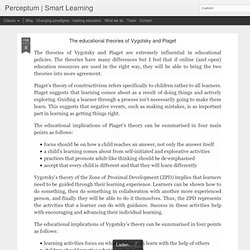
The theories have many differences but I feel that if online (and open) education resources are used in the right way, they will be able to bring the two theories into more agreement. Piaget’s theory of constructivism refers specifically to children rather to all learners. The ADDIE Instructional Design Model Infographic. Instructional Design Infographics The ADDIE Instructional Design Model Infographic The ADDIE instructional design model is possibly the best-known instructional design model.

The ADDIE model refers to Analyze, Design, Develop, Implement, and Evaluate. Furthermore, provides a step-by-step process that helps instructional designers plan and create training programs with a framework in order to make sure that their instructional products are effective and that their processes are as efficient as they can possibly be. Analyze In the analysis phase, the instructional problem is clarified, the instructional goals and objectives are established, and the learning environment and learner’s existing knowledge and skills are identified.
A Simple Guide To 4 Complex Learning Theories. Classical Conditioning. 1903 - Ivan Pavlov discovers Classical Conditioning Theory, while conducting research on the digestive system of dogs.
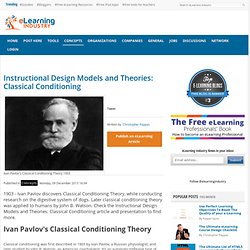
Later classical conditioning theory was applied to humans by John B. Watson. Check the Instructional Design Models and Theories: Classical Conditioning article and presentation to find more. Classical conditioning was first described in 1903 by Ivan Pavlov, a Russian physiologist, and later studied by John B. Watson, an American psychologist. Pavlov’s Dogs While doing research on the digestive system of dogs, Pavlov encountered a phenomenon he labeled “psychic reflexes”. John B. The Jigsaw Classroom: A Cooperative Learning Technique.
Σημειώσεις ψυχολογίας. Οι θεωρίες μάθησης χωρίζονται σε 4 κατηγορίες α. τις συνειρμικές ή συμπεριφοριστικές β. τις γνωστικές ή διάμεσες γ. τις κοινωνικογνωστικές δ. τις θεωρίες προγραμματικής δράσης α.

Φιλοσοφικό Υπόβαθρο: Αριστοτέλης και Άγγλοι εμπειριοκράτες. – tabula rasa – μετρήσιμη συμπεριφορά – ερέθισμα, αντίδραση, από το 1900 μέχρι το 1950. Pavlov (1900): Κλασική εξαρτημένη μάθηση. Blended Learning Models - 2002. Cooperative Learning Strategies and Children. ERIC Identifier: ED306003 Publication Date: 1988-00-00 Author: Lyman, Lawrence - Foyle, Harvey C.
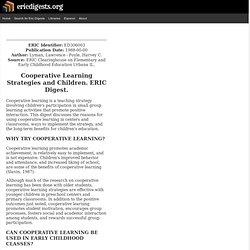
Source: ERIC Clearinghouse on Elementary and Early Childhood Education Urbana IL. Cooperative learning is a teaching strategy involving children's participation in small group learning activities that promote positive interaction. This digest discusses the reasons for using cooperative learning in centers and classrooms, ways to implement the strategy, and the long-term benefits for children's education. Old.primedu.uoa.gr/sciedu/old/books/book_proseg/kef2.htm. 2.3 Ôé åßíáé ï êïíóôñïõêôéâéóìüò;

Social Development Theory (Vygotsky. Summary: Social Development Theory argues that social interaction precedes development; consciousness and cognition are the end product of socialization and social behavior.
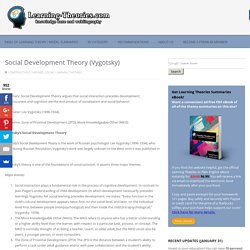
Originator: Lev Vygotsky (1896-1934). Key terms: Zone of Proximal Development (ZPD), More Knowledgeable Other (MKO) Vygotsky’s Social Development Theory Vygotsky’s Social Development Theory is the work of Russian psychologist Lev Vygotsky (1896-1934), who lived during Russian Revolution. Vygotsky’s work was largely unkown to the West until it was published in 1962. LEARNET: Living Education And Resources Network by the Brain Injury Association of New York State. Educational Psychology Review, Volume 3, Number 3. Dual coding theory (DCT) explains human behavior and experience in terms of dynamic associative processes that operate on a rich network of modality-specific verbal and nonverbal (or imagery) representations.

We first describe the underlying premises of the theory and then show how the basic DCT mechanisms can be used to model diverse educational phenomena. The research demonstrates that concreteness, imagery, and verbal associative processes play major roles in various educational domains: the representation and comprehension of knowledge, learning and memory of school material, effective instruction, individual differences, achievement motivation and test anxiety, and the learning of motor skills. DCT also has important implications for the science and practice of educational psychology — specifically, for educational research and teacher education. B. F. Skinner. Burrhus Frederic (B.
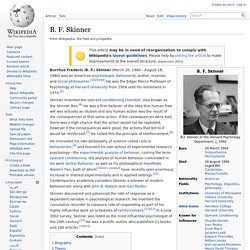
F.) Skinner (March 20, 1904 – August 18, 1990) was an American psychologist, behaviorist, author, inventor, and social philosopher.[1][2][3][4] He was the Edgar Pierce Professor of Psychology at Harvard University from 1958 until his retirement in 1974.[5] Skinner invented the operant conditioning chamber, also known as the Skinner Box.[6] He was a firm believer of the idea that human free will was actually an illusion and any human action was the result of the consequences of that same action. If the consequences were bad, there was a high chance that the action would not be repeated; however if the consequences were good, the actions that led to it would be reinforced.[7] He called this the principle of reinforcement.[8] He innovated his own philosophy of science called radical behaviorism,[9] and founded his own school of experimental research psychology—the experimental analysis of behavior, coining the term operant conditioning.
Συμπεριφοριστικές Θεωρίες Μάθησης. Learning Theories. Learning Theories. Learning Theories. Technology in Education. Facilitating learning transfer through students’ schemata  Θεωρίες μάθησης και εφαρμογές στη διδακτική - ksetrikala. Bloom's Taxonomy. From Emerging Perspectives on Learning, Teaching and Technology Mary Forehand The University of Georgia Introduction One of the basic questions facing educators has always been "Where do we begin in seeking to improve human thinking?

" (Houghton, 2004). Fortunately we do not have to begin from scratch in searching for answers to this complicated question. Benjamin S. Why #Connectivism is not a Learning Theory « A Point of Contact. Firstly, the question of how to label Connectivism is an important one because this affects how people connect with the theory. As a relatively young theory, its growth, acceptance, employment and how people actually understand Connectivism all depend partially on how it is represented. Representing a theory inaccurately limits the quality of the potential connections made with that theory, an insurmountable obstacle for such a theory that is concerned with the creation of successful networks and connections of specific quality to support this success.
Secondly, to be clear, my position isn’t one of anti-Connectivism.